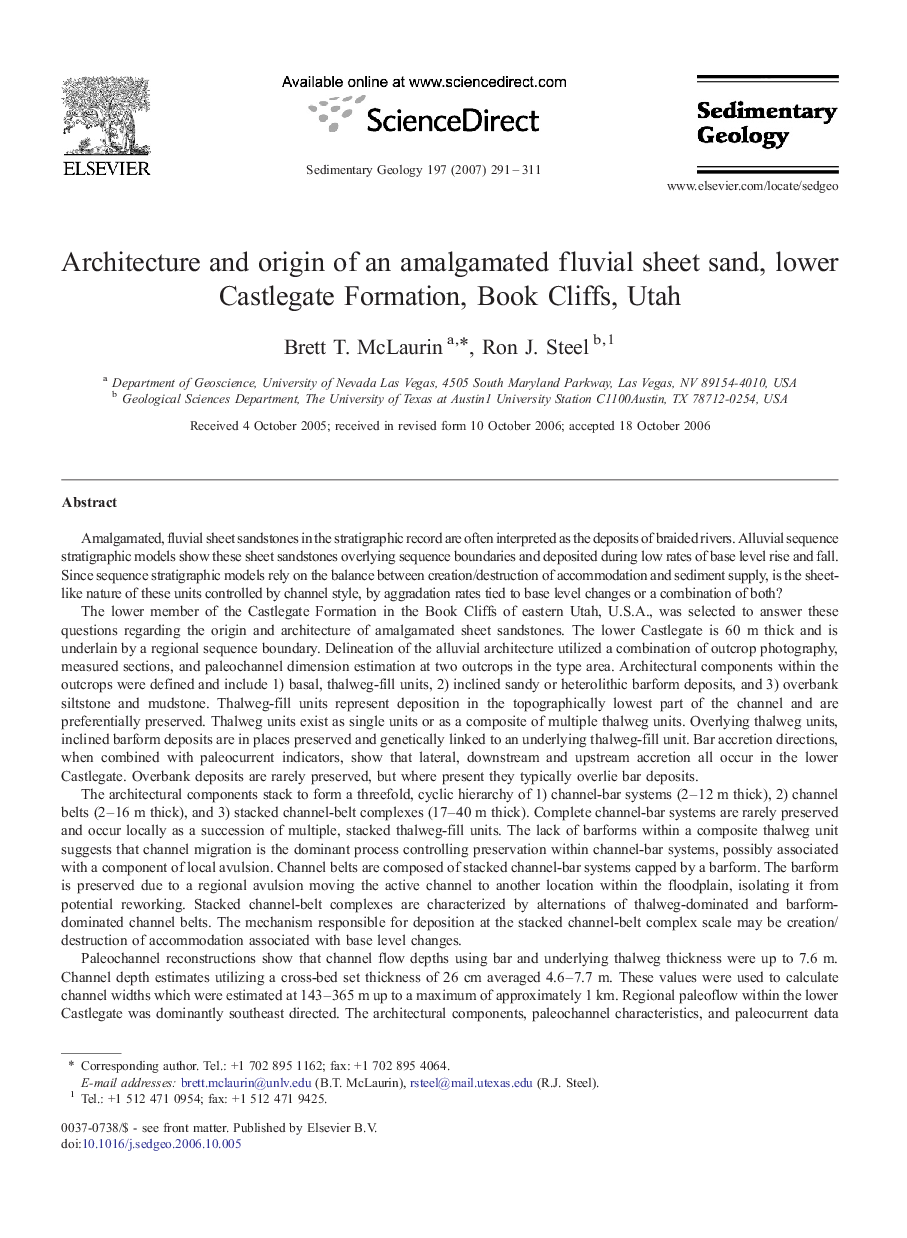| کد مقاله | کد نشریه | سال انتشار | مقاله انگلیسی | نسخه تمام متن |
|---|---|---|---|---|
| 4690919 | 1636171 | 2007 | 21 صفحه PDF | دانلود رایگان |

Amalgamated, fluvial sheet sandstones in the stratigraphic record are often interpreted as the deposits of braided rivers. Alluvial sequence stratigraphic models show these sheet sandstones overlying sequence boundaries and deposited during low rates of base level rise and fall. Since sequence stratigraphic models rely on the balance between creation/destruction of accommodation and sediment supply, is the sheet-like nature of these units controlled by channel style, by aggradation rates tied to base level changes or a combination of both?The lower member of the Castlegate Formation in the Book Cliffs of eastern Utah, U.S.A., was selected to answer these questions regarding the origin and architecture of amalgamated sheet sandstones. The lower Castlegate is 60 m thick and is underlain by a regional sequence boundary. Delineation of the alluvial architecture utilized a combination of outcrop photography, measured sections, and paleochannel dimension estimation at two outcrops in the type area. Architectural components within the outcrops were defined and include 1) basal, thalweg-fill units, 2) inclined sandy or heterolithic barform deposits, and 3) overbank siltstone and mudstone. Thalweg-fill units represent deposition in the topographically lowest part of the channel and are preferentially preserved. Thalweg units exist as single units or as a composite of multiple thalweg units. Overlying thalweg units, inclined barform deposits are in places preserved and genetically linked to an underlying thalweg-fill unit. Bar accretion directions, when combined with paleocurrent indicators, show that lateral, downstream and upstream accretion all occur in the lower Castlegate. Overbank deposits are rarely preserved, but where present they typically overlie bar deposits.The architectural components stack to form a threefold, cyclic hierarchy of 1) channel-bar systems (2–12 m thick), 2) channel belts (2–16 m thick), and 3) stacked channel-belt complexes (17–40 m thick). Complete channel-bar systems are rarely preserved and occur locally as a succession of multiple, stacked thalweg-fill units. The lack of barforms within a composite thalweg unit suggests that channel migration is the dominant process controlling preservation within channel-bar systems, possibly associated with a component of local avulsion. Channel belts are composed of stacked channel-bar systems capped by a barform. The barform is preserved due to a regional avulsion moving the active channel to another location within the floodplain, isolating it from potential reworking. Stacked channel-belt complexes are characterized by alternations of thalweg-dominated and barform-dominated channel belts. The mechanism responsible for deposition at the stacked channel-belt complex scale may be creation/destruction of accommodation associated with base level changes.Paleochannel reconstructions show that channel flow depths using bar and underlying thalweg thickness were up to 7.6 m. Channel depth estimates utilizing a cross-bed set thickness of 26 cm averaged 4.6–7.7 m. These values were used to calculate channel widths which were estimated at 143–365 m up to a maximum of approximately 1 km. Regional paleoflow within the lower Castlegate was dominantly southeast directed. The architectural components, paleochannel characteristics, and paleocurrent data suggest the lower Castlegate member was deposited in low to intermediate-sinuosity rivers influenced by autocyclic processes at smaller scales and allocyclic processes at the larger outcrop scale.
Journal: Sedimentary Geology - Volume 197, Issues 3–4, 15 April 2007, Pages 291–311